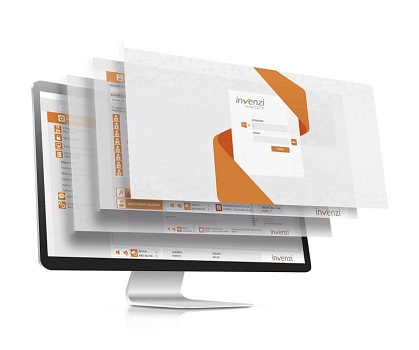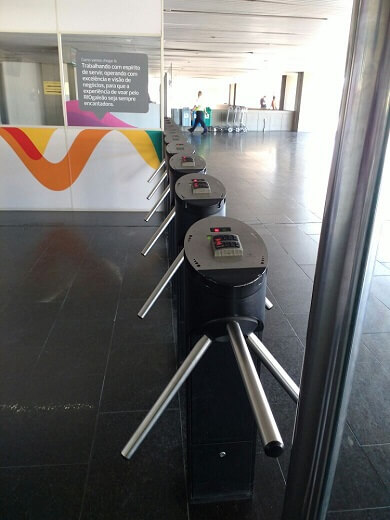asmag.com spoke with Andre Silva, CEO of Brazilian access control company Invenzi on securing Brazil's largest international airport.
Invenzi is a Brazilian company that has been operating for over 13 years in the corporate access control market and started expanding its operations to other countries just over a year ago.
We spoke with Andre Silva, the company's CEO, about one of its key projects – providing an access control solution for
Tom Jobim International Airport, the largest international airport in Brazil.
Tell us a little bit about Invenzi: What is your main line of business, key products, areas of operation?

Invenzi is a Brazilian company that has been operating for over 13 years in the corporate access control market and started expanding its operations to other countries just over a year ago. We have a well-known commercial and technical support team to serve all of Latin America.
We are the manufacturer of
Invenzi W-Access, which is an open software platform for corporate access control. It is a 100% web solution integrated with several manufacturers of access control equipment and VMS systems, among others. One of its great differentials is that it allows for many types of parametrization and customization, making its application go beyond traditional access control, helping the client in operational challenges of the most varied complexities. This ability to parameterize and customize the system allows Invenzi W-Access to be used in a large number of verticals.
Can you briefly introduce the facility (RIOGaleao airport), the customer and the integrator involved in the project?
Tom Jobim International Airport is the largest international airport in Brazil in size, and the second in terms of passenger movement. In 2014 it was granted to the private sector through RIOGaleão, which started a transformation process, with an investment of around US$ 500 million becoming an airport with international standard, capacity to receive up to 37 million passengers per year, with new infrastructure, diversified services and state-of-the-art technology.
RIOGaleão has the experience and recognition of Changi Airports International (CAI) as an investor and operator of major airports in the world, including Changi Airport, which has already been named the best airport for some years by the British consultancy Skytrax.
In 2015, following the airport modernization project, our integrator
Planna Sistemas won the first phase of implementation of a new access control system with our solution. The project continues to expand to this day.
What was the project objective? Key challenges? What was the main problem they wanted to solve?
The challenge was to design and implement an access control system for about 30,000 users, initially with 550 controllers and different integrations with specific interfaces for operation. Today, the system has more than 900 controllers installed.
The airport had a mix of access control solutions from different manufacturers and technologies, which did not work in an integrated manner and were already obsolete. In addition, hundreds of restricted areas were still controlled by keys, making the operation unsafe and slow, since the keys were often lost and doors were breached without any type of alarm. The airport also had a completely manual user registration system, which was also subject to serious operational problems that compromised the security of the entire operation.
What are some of the unique challenges of this installation that are not present in other projects?
In Brazil, all places that move imported goods must have their access of people and vehicles monitored in detail. In addition to providing historical reports on all movements of people and vehicles in the controlled areas, such information needs to be sent in real time to the Brazilian government's systems. As the airport has a large cargo terminal, the project needed to meet these requirements too.
What kind of integrations did the client ask for?

The airport has a floating population of more than 30,000 users. Every day dozens of people are activated and deactivated in the accreditation system. However, with the previous access control systems, all these changes had to be recorded manually. Now, through the Invenzi W-Access API, databases are always kept in sync, significantly increasing the security of the operation.
The cargo terminal also needed the urgent implementation of an access control system that could adapt the terminal's operation to the new regulations of the federal customs control agencies. It was necessary to report in real time all the movement of people and vehicles to the corresponding government agencies. Through APIs, integration with the airport's customs systems, which runs on SAP, was carried out.
Integration with the airports´s VMS system was also required. Almost all the doors are covered by at least one camera.
What kind of solution did you propose for the airport project?
The vast majority of controlled points are doors. In order to facilitate access control, we chose a PoE controller capable of powering the two Mifare readers of each door and the 600kg electromagnetic lock. Thus, it was only necessary to install a network point on each door, greatly speeding up the required project infrastructure installation.
To increase system security, all controlled points have entry and exit readers, allowing for sophisticated zone control with global anti-passback and control of the exact number of people in each environment, including runway areas. In the most critical zones, Mifare readers with a keypad for entering the password were installed.
Are there any other use cases, beyond security, that the access control system can be used for?
The city of Rio de Janeiro is the main tourist destination in Brazil and the airport is served by a huge fleet of taxis. RIOGaleão set up a large support structure for the circulation of these taxis, but the entire operation was done manually, with statistics done by sampling.
The Invenzi W-Access enabled the system to carry out detailed and real-time control of the entire taxi operation, from access control to parking lots, via vehicle queue management and passenger boarding area monitoring. The system ensures that only authorized taxis can operate at the terminals, as well as generate valuable statistics that are used to charge taxi companies for the use of the facilities. After the system was implemented, the customer observed that only a fraction of the amounts actually owed by these companies were charged.
To achieve this, several vehicle control points were implemented with RFID tag antennas and LPR cameras, giving the system more than 99% accuracy in identifying vehicles in motion. Additionally, several reports and system management dashboards were developed.
What are the key benefits the client saw in the solution?
The flexibility and adaptability of Invenzi W-Access allowed for the advanced degree of integrations required for this project. For example, the diversification of user registration user-interface layouts, variety of customization rules, specific dashboard and reporting tools, database partitioning, and several other advantages.
Were there any unexpected challenges during the project? How were they solved?
Although obsolete, the existing systems were in operation, meaning that the migration to the new system had to be very well planned so that there were no interruptions in the security of critical areas already controlled, such as the departure gates and areas related to immigration, which are being managed by the Federal Police. A joint planning process was carried out among the teams from Invenzi, the integrator and the airport operation teams so that these critical points would not have their operations interrupted for more than two hours at a time. It was a big challenge, but everything went as planned and the customer started to feel the benefits of the new system in a very short time.
Can you tell us a little bit about the project after its completion?
The implementation was successful and it was possible to meet and, in some cases, exceed customer expectations. With the system in place, all processes for registering people and vehicles, and managing alarms and incidents significantly improved, increasing security and reducing response times through the various integrations implemented.
The system now controls around 30,000 active employees from various companies that participate in the operation and transit through RIOGaleão – Tom Jobim International Airport. As the turnover of these employees is very high, the system already has a history of registrations and events of more than 250,000 people registered over five years of operation.
The more than 900 controlled points register around 28,000 daily accesses by people and vehicles, bringing security and convenience to users, and improving the operational capacity of the airport's management teams.